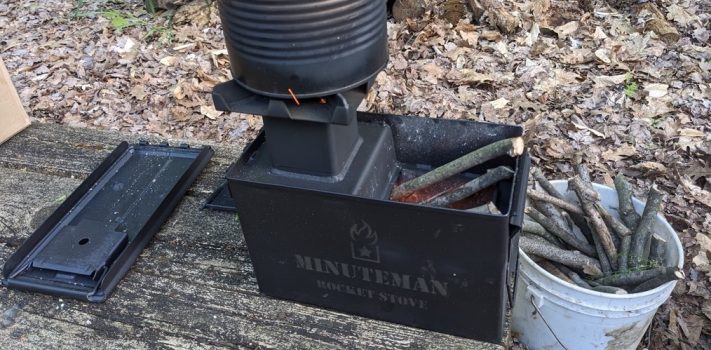God created man in His own image. One way that mankind reflects God’s image is through creativity. That is why observing creativity gives us such joy. It reveals a little bit of what God is like. I remember feeling that joy the first time I saw a Swiss Army Knife and the first time I saw a Leatherman Multi-Tool. These things are small reflections of the creativity of the Maker of human eye, the running cheetah, and the towering oak.
Recently, I had another moment of joy when I first ran across the Minuteman Rocket Stove online. I thought it was a wonderfully fun idea to build a rocket stove inside of an M2A1 .50 cal ammo can. It gives the stove excellent portability, as well as a unique aesthetic appeal.
I contacted Mr. Lane Miller, owner of the Minuteman Provision Company, and asked if he could provide me with a sample of the stove for testing and evaluation. He was kind enough to agree. About a week later, a package arrived via USPS Priority Mail.
First Impressions
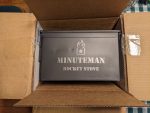 The first thing that impressed me about the stove was how heavy it is. The unopened Priority Mail package weighed 18.8 pounds on our digital bathroom scale. This is because the stove is made out of a much heavier gauge of metal than I anticipated. The stove will not quickly burn or rust through because it is so solidly made. The stove was well packaged with a smaller box well padded inside a larger box to protect it during shipment. I was not surprised to see this, since Mr. Miller had mentioned in a telephone conversation that the only stove returns he had experienced to date involved damage that took place during shipment.
The first thing that impressed me about the stove was how heavy it is. The unopened Priority Mail package weighed 18.8 pounds on our digital bathroom scale. This is because the stove is made out of a much heavier gauge of metal than I anticipated. The stove will not quickly burn or rust through because it is so solidly made. The stove was well packaged with a smaller box well padded inside a larger box to protect it during shipment. I was not surprised to see this, since Mr. Miller had mentioned in a telephone conversation that the only stove returns he had experienced to date involved damage that took place during shipment.
In addition to the stove, the box contained a “Forever 50″ Fire Starter, and a one pound bag of Maya Sticks Fire Starting Tinder.
 The “Forever 50″ Fire Starter is a gigantic, 8.5-inch long and 0.5-inch thick ferrocerium rod that uses a .50 BMG cartridge case as a handle. I cannot imagine how many fires would need to be ignited to wear this huge ferro rod down.
The “Forever 50″ Fire Starter is a gigantic, 8.5-inch long and 0.5-inch thick ferrocerium rod that uses a .50 BMG cartridge case as a handle. I cannot imagine how many fires would need to be ignited to wear this huge ferro rod down.
The Maya Sticks are pieces of Central American fatwood to use as tinder and kindling. The sticks are pleasantly aromatic, and relatively light.
I carefully read the directions for the stove, ferro rod, and fatwood, and prepared to begin my testing.
Test Session 1
It was a beautiful, sunny evening in late spring with a temperature of about 70 degrees Fahrenheit and a little breeze.
I prepared for the session by gathering fuel. First I used a heavy knife to chop up sticks up into segments about 6 inches long and up to 1 inch thick. It was difficult for the knife to cut through some of the thicker sticks, so I switched to a hatchet. The problem with the hatchet was that many of the sticks I chopped flew spinning off into the underbrush. Rather than spend a lot of time searching for errant sticks in the underbrush, I just cut roughly twice as many sticks as I needed, and only recovered the ones that landed nearby.
Back in June of 2021, SurvivalBlog published an article I had written about making waterproof tinder from cotton balls impregnated with a combination of paraffin and petroleum jelly. I took one of these waterproof tinder balls, pulled it in half to expose fine fibers, put it on the lid of the stove, and ignited it with the “Forever 50″ ferro rod. The rod did an excellent job if lighting the tinder on the very first strike.
I then took two sticks, used them as pincers to pick up the burning tinder, dropped the burning tinder down the chimney end of the stove, and added some small twigs on top. I then put the chimney extension on the stove to preheat.
I made the transition from small sticks to large sticks too quickly, and almost put the fire out. I needed to go back to smaller sticks for a while to get things burning well again.
The chimney end of the stove was drawing nicely within 10 minutes. I then took a number 10 can, put 2+ quarts of water in the can, and set the can on the grate on the top of the chimney extension to boil. I was impressed with the relative smokelessness of the flame.
A slight breeze developed, and shifted direction a number of times. I was able to put on a pair of heavy leather gloves, and rotate the stove so that the wind was blowing into the firebox and thus assisting with the draft.
In spite of the fact that I was still learning how to feed the stove most effectively, the water was steaming within 12 minutes, and simmering within 23 minutes. But by 30 minutes the airway was beginning to get clogged with excessive ash. I removed the can of water from the burner, removed the chimney extension, and dumped the excess ashes into the fire pit. I then put the stove back together and fed more sticks into the firebox. There were enough embers in the firebox to light the sticks, and the stove now lived up to its name by creating a rocket-like stream of flame. Within 10 minutes, the water in the can was in a full rolling boil.
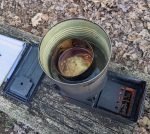 I took advantage of the burning stove to make some more waterproof tinder. I poured off about half of the boiling water, and then put a 13-ounce jar of petroleum jelly into the number 10 can to melt. I also put a smaller can containing a five-ounce bar of paraffin on top of the jar of petroleum jelly. When the petroleum jelly was melted, I poured it into the smaller can with the melting paraffin and placed that can back into the larger can with the boiling water to allow the paraffin to continue to melt.
I took advantage of the burning stove to make some more waterproof tinder. I poured off about half of the boiling water, and then put a 13-ounce jar of petroleum jelly into the number 10 can to melt. I also put a smaller can containing a five-ounce bar of paraffin on top of the jar of petroleum jelly. When the petroleum jelly was melted, I poured it into the smaller can with the melting paraffin and placed that can back into the larger can with the boiling water to allow the paraffin to continue to melt.
When the paraffin was fully melted, I poured the paraffin/petroleum jelly mixture into a gallon-sized re-sealable plastic bag that contained 100 cotton balls. Wearing insulated rubber gloves, I squeezed the air out of the plastic bag and sought to evenly distribute the paraffin/petroleum jelly mixture through the cotton balls. I then set the bag containing the paraffin/petroleum jelly-impregnated cotton balls on the workbench in the pole barn to cool.
Finally, I removed the chimney extension from the stove, dumped the embers from the stove into the fire pit, and brought the stove into the pole barn to cool.
I had a lot of fun indulging my pyro-maniacal tendencies and also enjoyed preparing extra waterproof tinder.
Test Session 2
It was a warm, humid evening in late spring. It had rained earlier in the day, and the mosquitoes were out in force. I needed to put on a bug jacket to protect myself from their attacks.
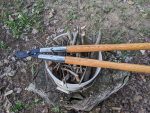 I used pruning shears rather than a knife or hatchet to prepare a bucket of sticks to use as fuel. This worked well in the sense that fewer sticks flew spinning off into the underbrush. I should, however, have worn gloves, since the pruning shears raised a couple of blisters during this process.
I used pruning shears rather than a knife or hatchet to prepare a bucket of sticks to use as fuel. This worked well in the sense that fewer sticks flew spinning off into the underbrush. I should, however, have worn gloves, since the pruning shears raised a couple of blisters during this process.
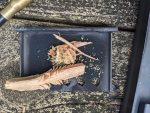 I took a Maya stick, scraped it with my EDC knife to create some sawdust, cut off some small shavings, and then cut the Maya stick in half. I then feathered one-half of the Maya stick. Next, I took the “Forever 50″ ferro rod and used it to ignite the fatwood dust. This required several strikes with the rod. When the dust ignited, the flame quickly spread to the shavings, and the shavings easily lit the feathered stick. I then used two sticks as pincers to transfer the burning feathered stick into the chimney end of the stove. Next, I added some small sticks on top of the burning feathered stick, and placed the chimney extension on the stove.
I took a Maya stick, scraped it with my EDC knife to create some sawdust, cut off some small shavings, and then cut the Maya stick in half. I then feathered one-half of the Maya stick. Next, I took the “Forever 50″ ferro rod and used it to ignite the fatwood dust. This required several strikes with the rod. When the dust ignited, the flame quickly spread to the shavings, and the shavings easily lit the feathered stick. I then used two sticks as pincers to transfer the burning feathered stick into the chimney end of the stove. Next, I added some small sticks on top of the burning feathered stick, and placed the chimney extension on the stove.
I preheated the chimney for 5 minutes, and then swept the burning embers toward the firebox end of the stove. I then added fuel, and put a number 10 can with 2+ quarts of water on the grate to heat.
The water in the can was simmering within 20 minutes and on the verge of a rolling boil just a few minutes later. For the next 30 minutes, I felt like Sisyphus trying to roll his rock up the hill. Every time the water was about to boil, I would have to add more fuel, and the pot would go back to simmering until the new fuel caught fire. Just as the water would start boiling again, I would need to add more fuel yet again. I found this frustrating, since I had managed to bring the same volume of water to a rolling boil just the day before. I needed to do further research to find out how to better sustain the flame.
Test Session 3
I had a sense that I was not getting the most out of the stove, so I viewed a video on YouTube that was linked from the Minuteman Stove site. That video showed the stove being used to boil 5 pounds of potatoes in an 8 quart Dutch oven.
My key takeaway from the video is that I was babying the stove too much. I was trying to keep all of the flame contained in the firebox. As a result, I was carefully feeding small short sticks into the box. In the video they used larger, longer sticks that stuck up out of the firebox. At times in the video, a significant amount of flame was coming up out of the firebox instead of the chimney. This did not seem to be a problem. So I decided that another test session was in order.
This time, I used a bypass lopper for fuel preparation. It was the ideal tool for the job. It could easily cut through sticks that were difficult to cut with the pruning shears in test session 2. It did not cause fuel to go spinning off into the underbrush like the knife and the hatchet had done in test session 1.
I took a piece of the waterproof tinder that I had prepared in test session 1, pulled it in half, lit it with the “Forever 50″ ferro rod, and dropped it into the chimney half of the stove by using a couple of sticks as pincers. I then added a number of smaller sticks, put on the chimney extension, dropped some slightly larger sticks down the chimney extension, and then allowed the chimney to preheat for about 5 minutes.
Next, I swept some burning sticks from the chimney half of the stove into the firebox, and added some longer sticks on that end. When the additional sticks were burning well, I took a #10 can, put 2+ quarts of water in it, and placed it on the grate. I continued to add longer sticks as fuel was consumed.
Within 13 minutes, the water in the can was steaming, and within 20 minutes it was engaged in a full rolling boil. A more aggressive approach to feeding the stove was the key to better heat output.
I felt that sticks up to 1/3 inch thick were the optimum size. Thicker sticks would also burn, but not as vigorously.
Conclusions
The Minuteman Rocket Stove put out more heat than the twig stoves I have previously tested, with less soot left on the cookware. It seems durable enough to provide a lifetime of service, but is too heavy for field use in the absence of vehicular transport.
The “Forever 50″ ferro rod does an excellent job of igniting fires, and should far outlast my lifetime based on the amount of wear that starting each fire produces on the rod.
Maya sticks do an excellent job as tinder and kindling. I prefer my own waterproof tinder balls because I can make them myself from materials that are inexpensively available locally. I have found birchbark to be an excellent, naturally-renewable, alternative that grows locally as well. But those are matters of personal preference, and the Maya sticks are also an excellent choice.
 Although putting a rocket stove inside an ammo can offers many advantages in terms of portability and aesthetics, there may be some even more effective options in terms of maximum heat output. Minuteman Provision Company offers several other stoves (the Stinger, K Stove, and Titan), whose designs seem better optimized in terms of fuel feed, airflow, and chimney height. Unless you need the additional portability afforded by the ammo can, then I recommend that you try one of these other models instead. I hope to test one or more of them in future years.
Although putting a rocket stove inside an ammo can offers many advantages in terms of portability and aesthetics, there may be some even more effective options in terms of maximum heat output. Minuteman Provision Company offers several other stoves (the Stinger, K Stove, and Titan), whose designs seem better optimized in terms of fuel feed, airflow, and chimney height. Unless you need the additional portability afforded by the ammo can, then I recommend that you try one of these other models instead. I hope to test one or more of them in future years.
By the way, Minuteman also produces some Faraday electronics protection boxes that look quite interesting for preparing for possible EMP or Carrington-level events.
The Minuteman Stove cost $239.95 at the time of this writing, the “Forever 50″ Fire Starter cost $29.95 and a one pound bag of Maya Sticks cost $22.95.
Disclaimer
Mr. Lane Miller of Minuteman Provision Company was kind enough to provide me with a sample of the rocket stove, “Forever 50″ ferro rod, and Maya sticks fatwood for testing and evaluation. I tried not to let his kindness interfere with my objectivity in this review, and believe that I have succeeded. I did not receive any other financial or other inducement to mention any vendor, product, or service in this article.

